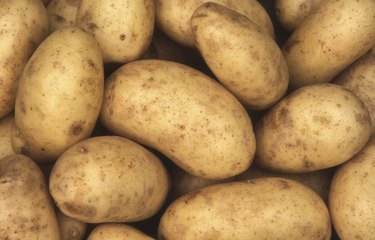
Potatoes (Solanum tuberosum) are a staple of the American diet and a common ingredient in many foods. While they're heavily cultivated commercially, potatoes are also fairly easy to grow at home in your vegetable garden, and learning how to store seed potatoes makes it easy to plant them when you're ready. If you've grown potatoes in the past and want another crop this year, you may have considered using seed potatoes. Proper storage and care of your seed potatoes can mean all the difference when it comes to a healthy, bountiful crop.
What Are Seed Potatoes?
Video of the Day
You grow seed potatoes specifically for replanting to produce a potato crop. They're not a different kind of potato. Instead, it's their purpose that causes them to have a different classification.
Video of the Day
Potatoes are tubers, which means they grow as the food supply for the leafy green part of their plant. The tuber grows larger underground to store food for the plant. If provided proper nutrients, tubers like potatoes grow sprouts underground, from structures we call eyes. The sprouts that develop from potato eyes then grow into new plants.
You might think that you can start a potato crop using store-bought potatoes. However, most of the potatoes sold to grocery stores have chemical treatments so they don't grow eyes while on the shelf. As a result, they're far less likely to be effective as seed potatoes. In addition, the chance of a diseased potato crop is much greater if you use store-bought potatoes.
How to Harvest Seed Potatoes
To harvest seed potatoes, dig up any potatoes you wish to store for next year. Brush the soil off the potatoes, but don't wash them. You may also purchase certified disease-free potatoes from a garden supply or home improvement store. Starting fresh with certified seed potatoes each year lessens the risk of an infected and damaged crop.
If you choose homegrown seed potatoes, practice crop rotation, planting your potatoes in a different place each year to prevent disease. Not only is this important for the yield of your harvest, it's essential for your seed potatoes. This is because diseases carried by these seed potatoes are likely to persist into another growing season.
Another way to maximize the return on your crop is to harvest seed potatoes of varying types, including heirloom varieties. If you do accidentally introduce a disease to your crop, you might have a higher yield if you've established a diverse population.
How to Store Seed Potatoes
You should store your seed potatoes in a cool, dry place around 50 degrees Fahrenheit. While some humidity is essential for your seed potatoes, you shouldn't expose them to too much moisture, or they may rot. It's critical that potatoes have time to rest, so you shouldn't move or expose them to light or heat during the storage period. Locations like cool closets or cellars are excellent places for seed potatoes. If you store your potatoes in a basement, place them so that mice or other pests can't get to them.
Keep the potatoes in a cardboard box or brown paper bag during their hibernation period. They require ventilation, so don't stack or pile the potatoes too high. Additionally, don't cover or close the container so that air cannot enter.
Three to four weeks before you intend to plant your crop, move your seed potatoes to a well-lit area with high humidity. A sunny window or under a grow light is an excellent choice. The purpose of this exercise is to encourage the sprouting of your potatoes. Covering seed potatoes with moist burlap bags can also aid in the sprouting process.
How to Plant Seed Potatoes
If your seed potatoes are small, you don't need to cut them. However, if you stored large potatoes, you should cut them into pieces with two to three eyes each. Each piece should weigh about two ounces to maximize your crop yield. Allow cut potato pieces to dry for several days before you plant them.
Plant your seed potatoes in well-draining, rich and fertilized soil that is 6 inches deep. If you choose to hill your potatoes, mound the dirt covering them and add a layer of mulch on top. Keep hills about 1 foot apart. Water your seed potatoes regularly, providing each plant 2 inches of water per week.